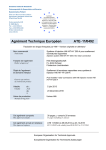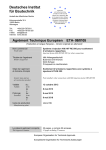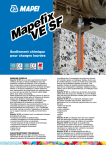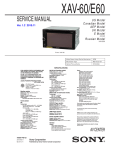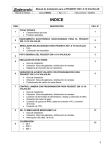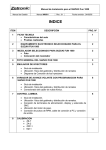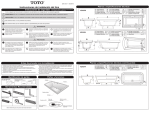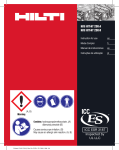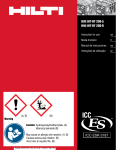Download Hilti 284267 Installation Guide
Transcript
00_Cover_HIT_Profi_P1.qxd 13.12.2006 13:33 Uhr Seite 10 Hilti HIT Gebrauchsanleitung de Installation instructions en Mode d’emploi fr Instrucciones de uso es Gebruiksaanwijzing nl 00_Cover_HIT_Profi_P1.qxd I 13.12.2006 13:33 Uhr Seite 1 00_Cover_HIT_Profi_P1.qxd 13.12.2006 13:33 Uhr Seite 2 I 2x 2x 2x 00_Cover_HIT_Profi_P1.qxd 13.12.2006 13:33 Uhr Seite 3 I 2x 2x 2x 00_Cover_HIT_Profi_P1.qxd 13.12.2006 13:33 Uhr Seite 4 I 2x 2x 2x 02_BA_HIT_Profi_P1_en.qxd 13.12.2006 13:37 Uhr Seite 11 Hilti HIT (-HY 150, -HY 150 MAX and -RE 500) Installation Instructions for fastenings in concrete Observe these instructions for use and safety precautions before using Hilti HIT systems. International and national approvals takes precedence for approval governed applications. Observe the Instructions for Use provided with each foil pack and the dispenser in use. Safety Regulations: en Review the Material Safety Data Sheet (MSDS) before use! Wear well-fitting safety glasses, protective gloves and suitable protective clothing when working with Hilti HIT. For application specific information, refer to the Hilti technical literature. For the availability of the Hilti products referenced in this document, please contact your local Hilti representative. Abbreviations: do = Borehole diameter ds = Element diameter c = Concrete cover over the post installed element (rebar applications) cdrill = Distance of borehole axis to concrete surface inst = Embedment depth m = Mortar level mark tcure, full = Full curing time tcure, ini = Initial curing time tgel = Gel / working time Ø = Drill bit diameter MSDS HIT = Material Safety Data Sheet = Hilti Injection Technology Tables: Table I Table II Table III Table IV Table V Table VI The following guidance will help you to find your way in these installation instructions. Step 1 Depending on the drilling method and the base material condition (dry or water saturated / water filled / underwater), choose one of the four installation methods. See Table I for the overview of the installation methods. Step 2 The sequence of the single steps in the overall procedures is numbered and has to be followed accordingly. The icons are explained in detail in the text part of these instructions. Step 3 Depending on the application condition and borehole diameter, special accessories may be required. For the proper choice of the accessories please refer to Table II. = Installation methods = Accessories selector = Brushing extension selector = Blowing extension selector = Injection extension selector = Dispenser selector Contents 1. Borehole drilling 2. Borehole preparation 3. Borehole cleaning 4. Injection of mortar 5. Installation of the element Read the Installation Instructions for Use. Page 12 13 14 15 17 Step 4 In order to reach the bottom of the borehole for a selected installation procedure, the following tables will list the appropriate elongations: - Table III for the elongations used for brushing - Table IV for the elongations used for air cleaning - Table V for the elongations used for injecting Step 5 Table VI lists the most appropriate HIT dispenser. 11 02_BA_HIT_Profi_P1_en.qxd 13.12.2006 13:37 Uhr Seite 12 1. Borehole drilling The drilling method has an influence on the setting procedure. See Table I. In these installation instructions two different drilling methods, i.e. hammer drilling and diamond coring, are considered. For detailed information about additional drilling methods please contact Hilti. Hammer drilling en • Drill hole to the required embedment depth using a hammer-drill with an appropriately sized carbide drill bit set in rotation hammer mode. Diamond coring • Core drill hole to the required embedment depth using an appropriately sized diamond core drill bit. Remove all core fragments from the hole after drilling. Special Case: Splicing applications for reinforcement bars (rebars) To be in accordance with the design assumptions, concrete cover, parallel drilling to the surface and splice length must be carefully ensured during the installation. Splicing applications for rebars • Measure and verify concrete cover c. • cdrill = c + ds /2 • Drill parallel to concrete surface and to existing rebar. • Where required use drilling aid. Drilling aid Hammer drilling: use drilling aid for holes with inst > 20 cm (8") (check specific approval for details). Three different options may be considered a drilling aid: A) Hilti drilling aid HIT-BH • Secure the drilling aid etc. with HKD-S M10×40 or HST M10/10 (HDI 3/8" or KB3 3/8"). • Drill parallel to the guide rod. Precaution: Put a clearly visible mark on the guide rod. B) Slat or spirit level C) Visual control Diamond core rigs serve as drilling aids and need to be properly anchored prior to coring. Embedment mark Mark the embedment depth on the rebar (e.g. with tape) → inst. 12 02_BA_HIT_Profi_P1_en.qxd 13.12.2006 13:37 Uhr Seite 13 2. Borehole preparation For use in case of: diamond cored boreholes, holes filled with standing water and / or under water applications, observe the following steps prior to the borehole cleaning procedure. Flushing • Flush hole by inserting a water hose (water-line pressure) to the back of the hole until water runs clear. Perform this step twice. • Brush the hole 2 times with the specified brush size (brush Ø ≥ borehole Ø) by inserting the round steel brush to the back of the hole in a twisting motion. The brush shall produce natural resistance as it enters the anchor hole. If this is not the case, use a new brush or a brush with a larger diameter. See Table II for the corresponding round steel brush / drill bit combination. If required, extend the reach of a steel brush, HIT-RB, by attaching it to an extension HIT-RBV in order to reach the back of the borehole. Attach the other extension end into the brush handle HIT-RBH, according to Table III. Brushing • • • • Flushing • Flush the borehole again until water runs clear. Perform this step twice. • Brush extensions HIT-RBS for machine brushing shall be used to accomodate cleaning of boreholes deeper than 250 mm (10”) (for ds = 8 mm (3/8")…12 mm (1/2") or deeper than 20 xds (for ds > 12 mm (1/2")), respectively. Select the corresponding brush extension HIT-RBS according to Table III. Attach the round steel brush, HIT-RB, on to one end of the brush extension(s) HIT-RBS, in order to reach the back of the borehole. Secure the other extension end into the TE-C/TE-Y (-T) holder. Special Case: Machine Brushing • • • Tips: • Start machine brushing operation slowly. • Start brushing operation once brush is inserted in borehole. 13 en 0 02_BA_HIT_Profi_P1_en.qxd 13.12.2006 13:37 Uhr Seite 14 3. Borehole cleaning Load performances of chemical anchors are strongly influenced by the cleaning method. Inadequate borehole cleaning = poor load values. For safety relevant applications, please verify with the design engineer which cleaning method was assumed in the design phase. The borehole must be free of dust, debris, water when applicable, ice, oil, grease and other contaminants prior to mortar injection. en Compressed air • • • Blow from the back of the borehole with oil-free compressed air [min. 90 psi at 3.5 CFM (6 bar at 6 m3/hour)] until return air stream is free of noticeable dust. Perform this step 2 times. For boreholes deeper than 250 mm (10") (for ds = 8 mm (3/8") …12 mm (1/2")) or deeper than 20xds (for ds >12 mm (1/2")), respectively, use the appropriate air nozzle Hilti HIT-DL (oil free compressed air ≥ 6 bar) – see Table II for the corresponding air nozzle / drill bit combination. Connect the selected air nozzle with the appropriate air cleaning extension: HIT-DL 12–16 (HIT-DL 1/2" – 11/16") with HIT-DL 10/0.8 or HIT-DL V10/1 HIT-DL 18–32 (HIT-DL 3/4" – 1 3/8") with HIT-DL 16/0.8 or HIT-DL B and/or HIT-VL 16/0.7 and/or HIT-VL 16. See Table II for the corresponding air nozzle / drill bit combination. For applications with an effective embedment depth inst > 0.7 m (28"), please connect two or more blowing extensions HIT-DL with the connector HIT-DL K (See Table IV). For element diameter > 25 mm (1") the compressor must be rated to supply a minimum air flow of at least 140 m3/hour (82 CFM). Tips: Keep away from dust cloud, do not inhale concrete dust. Hilti recommends a dust collector or other equipment to be used to collect the dust during the blowing operation. • • Brushing • • Brush the borehole with an appropriately sized round steel brush. Perform this step 2 times. See above for details. Compressed air • 14 Blow out the hole again from the back of the hole with compressed air until return air stream is free of noticeable dust. Perform this step 2 times. 02_BA_HIT_Profi_P1_en.qxd 13.12.2006 13:37 Uhr Seite 15 Special Case: Manual Cleaning Blowing out • The Hilti manual pump may be used for blowing out boreholes up to diameters ds ≤ 16 mm (5/8") and borehole depths up to inst ≤ 250 mm (10") (please contact Hilti for further references). • Blow out at least 4 times from the back of the borehole. en 4x Brushing • Brush the borehole 4 times with an appropriately sized round steel brush. See above for details. Blowing out • Blow out at least 4 times from the back of the borehole. See above for details. 4. Injection of mortar Insert foil pack in foil pack holder • • • • Observe the instructions for use of the dispenser. Check foil pack holder for proper function. Put foil pack into foil pack holder. Do not use damaged foil packs/ holders. Tightly attach mixer to foil pack manifold • • • Use the static mixer that is delivered with the mortar. Attach the static mixer tightly on to the manifold before starting to dispense. Do not modify the static mixer. 15 0 02_BA_HIT_Profi_P1_en.qxd 13.12.2006 13:37 Uhr Seite 16 Insert foil pack holder with foil pack into dispenser • • en Push release trigger (1), retract plunger (2) and insert foil pack holder with foil pack into the appropriate Hilti dispenser (3). See Table VI for the selection of the most suitable HIT dispenser. 0 Discard initial amount of mortar • • • • • Observe the Instructions for Use of the mortar for the amount of mortar that has to be discarded. The foil pack is self opening when dispensing begins. Do not pierce the foil pack manually (this can cause system failure). After changing a mixer, the first trigger pulls must be discarded. For each new foil pack a new static mixer must be used. Inject mortar into borehole starting from the back of the borehole without forming air voids • • • 16 Inject the mortar from the back of the borehole by slowly withdrawing the mixer incrementely after each trigger pull, after controlling that the depth of the borehole corresponds to the design value. Important! Use extensions for deep holes, as explained under special case. Fill holes approximately 2/3 full, or as required to ensure that the annular gap between the anchor/rebar and the concrete is completely filled with mortar over the entire embedment length. 02_BA_HIT_Profi_P1_en.qxd 13.12.2006 13:37 Uhr Seite 17 Special Case: Injection with elongations and piston plug • The use of the piston plug is recommended for overhead applications or boreholes deeper than 250 mm (10"). For underwater applications the installation is only possible with the aid of piston plugs. • Connect the selected injection piston plug with the appropriate injection extension: HIT-SZ 12–16 (HIT-SZ 1/2" – 5/8") with HIT-VL 9/1.0 HIT-SZ 18–32 (HIT-SZ 11/16" – 1 3/4") with HIT-VL 16 or HIT-VL 16/0.7 • See Table II for the corresponding piston plug / drill bit combination. • For applications with an effective embedment depth inst > 800 mm (31"), please connect two or more injection extensions HIT-VL using the connector HIT-VL K (See Table V). In case of use of two or more rigid injection extensions HIT-VL 16/0.7, use a flexible tube HIT-VL 16 (0.5 m /20") prior to the connection to the static mixer. • • • • • • To aid installation, mark the required mortar level m and embedment depth inst with tape or marker on the mixer extension. Quick estimation: m = 1/3 • inst. The injection of mortar with a piston plug HIT-SZ (IP) helps to prevent the creation of air voids. The mixer extension with the piston plug should be inserted to the back of the borehole without resistance. During the injection the piston plug will be naturally pushed out the borehole by the mortar pressure. Attention! By pulling the mixer extension with piston plug, the piston plug may be rendered inactive and air voids may occur. Depressurize the dispenser • After injecting the mortar depressurize the dispenser by pressing the release button. This will prevent further mortar from escaping out of the mixer. 5. Installation of the element Insert element into the borehole • • • • • Mark the anchor/rebar at the required embedment depth. Set the anchor/rebar to the required embedment depth. Embedment depth must equal to the design specification. Before use, verify that the anchor/rebar is dry and free of oil or other residue. To ease installation, anchor/rebar may be slowly twisted as they are inserted. After installing an anchor/rebar the annular gap must be completely filled with mortar. 17 en 02_BA_HIT_Profi_P1_en.qxd 13.12.2006 13:37 Uhr Seite 18 tgel linst • • en Observe the gel time “tgel”, which varies according to the temperature of base material. Please refer to the Instructions for Use of the mortar for details about tgel. Minor adjustments to the anchor/rebar may be performed during the gel time. For the gel time see relevant information in the manual of the mortars. Attention! • For overhead applications take special care when inserting the anchor/rebar. • Excess mortar will be forced out of the borehole. Collect and remove it safely to protect the installer and the anchor/rebar. Avoid dripping of the mortar. • Position the anchor/rebar and secure it from falling during the curing time. 0 Do not disturb the element tcure • • Once the gel time “tgel” has elapsed, do not disturb the element until “tcure” has passed. Please refer to the Instructions for Use of the mortar for details about “tcure”. For rebar applications, do not disturb the element until “tcure,ini” has passed, if the mortar in use is characterised by “tcure,ini”, please refer to the Instructions for Use of the mortar for details about “tcure,ini”. Preparation work may continue for rebar applications • Between “tcure,ini” and “tcure,full” the mortar has a limited load bearing capacity. Do not apply the design load on the rebar during this time. 0 0 18 02_BA_HIT_Profi_P1_en.qxd 13.12.2006 13:37 Uhr Seite 19 Apply load/torque • After “tcure,full” has passed load/torque “Tinst” may be applied. Please refer to the Instruction for Use of the mortar for details about “tcure,full” and “Tinst ” 19 en 02_BA_HIT_Profi_P1_en.qxd 13.12.2006 13:37 Uhr Seite 20 00_Cover_HIT_Profi_P1.qxd 13.12.2006 13:33 Uhr Seite 5 II HAS HIS Rebar Ø [mm] Ø [mm] Ø [mm] Ø [mm] 10 12 14 16 18 20 22 24 25 28 30 32 35 37 40 42 45 47 52 55 8 10 12 8 16 10 Ø [inch] Ø [inch] 7/16 1/2 9/16 5/8 11/16 3/4 7/8 1 1 1/8 1 1/4 1 3/8 1 1/2 1 3/4 3/8 12 8 10 12 14 16 18 16 20 22 20 24 27 30 33 36 20 25 28 30 32 39 36 40 Ø [inch] 1/2 #4 3/8 1 1/4 1 1/2 1/2 5/8 3/4 #5 #6 #7 #8 #9 #10 #11 HIT-SZ (IP) Item no. HIT-DL Item no. 10 8/12 10/14 12/16 14/18 16/20 18/22 24 20/25 28 30 25/32 35 37 40 42 45 47 52 55 380917 336548 336549 336550 336551 336552 370774 380918 336553 380919 380920 336554 380921 382259 382260 382261 382262 382264 382265 382266 Item no. Item no. 7/16" 1/2" 9/16" 5/8" 11/16" 3/4" 7/8" 1" 1 1/8" 1 1/4" 1 3/8" 1 1/2" 1 3/4" 273203 273204 273205 273207 273209 273210 273211 273212 273214 273216 273217 273218 273219 – 274019 274020 274021 274022 274023 274024 274025 274026 274027 274028 274029 274030 Ø [inch] #3 5/8 3/4 7/8 1 HIT-RB – 8/12 10/14 12/16 14/18 16/20 18/22 24 20/25 28 30 25/32 35 37 40 42 45 47 52 55 1/2" 9/16" 5/8" 11/16" 3/4" 7/8" 1" 1 1/8" 1 1/4" 1 3/8" 1 1/2" 1 3/4" – 351989 351990 351991 351992 351993 269618 269619 351994 269620 269621 351995 269622 271499 269623 269624 269625 269626 271476 271477 Item no. – 8/12 10/14 12/16 14/18 16/20 16/20 16/20 20/25 20/25 20/25 25/32 25/32 25/32 25/32 25/32 25/32 25/32 25/32 25/32 – 371715 371716 371717 371718 371719 371719 371719 371720 371720 371720 371721 371721 371721 371721 371721 371721 371721 371721 371721 Item no. – 1/2" 9/16" 9/16" 11/16" 3/4" 7/8" 1" 1" 1" 1 3/8" 1 3/8" 1 3/8" – 38237 38238 38238 38239 38240 38241 38242 38242 38242 38243 38243 38243 00_Cover_HIT_Profi_P1.qxd 13.12.2006 13:33 Uhr Seite 6 III inst Item 0 –250 mm (0"– 10") 250–800 mm (10"– 31") Item no. 1 HIT-RBH 1 HIT-RBH > 800 mm (> 31") Depending on drilling machine Item no. 1) 371722 TE-C 1) 263437 TE-Y 1) 263439 229138 1–2 HIT-RBS 10 / 0.35 HIT-RBV 1) Item 229138 1 HIT-RBS 10/0.35 0 371722 TE-C 1) 263437 238727 TE-Y 1) 263439 HIT-RBS 10 / 0.7 336645 TE-C 1) 263437 TE-Y 1) 263439 1 – x Brush RBS 10/0.7 336645 TE-C 1) 263437 TE-Y 1) 263439 Ça depend du perforateur 1) Depende del marillo perforador 00_Cover_HIT_Profi_P1.qxd 13.12.2006 13:33 Uhr Seite 7 IV inst 0 –250 mm (0"– 10") 250–800 mm (10"– 31") Item Item no. Handpump 60579 G 1/4" Item G 1/4" HIT-DL 10/0.8 G 1/4" HIT-DL 16/0.8 > 800 mm (> 31") Item no. Item Item no. 381215 381215 HIT-DL A 38251 HIT-DL V10 / 1 336643 336644 381215 38252 HIT-DL A 336643 HIT-DL B 371714 HIT-VL 16 /0.7 336646 HIT-DL K 038250 HIT-DL A 336643 HIT-VL 16 038249 00_Cover_HIT_Profi_P1.qxd 13.12.2006 13:33 Uhr Seite 8 V inst Item 0 –250 mm (0"– 10") 250–800 mm (10"– 31") > 800 mm (> 31") HIT-M1 HIT-M3 HIT-RE-M Item no. Item Item no. 068156 348071 337111 HIT-M1 HIT-M3 HIT-RE-M 068156 348071 337111 HIT-VL 16 038249 HIT-M1 HIT-M3 HIT-RE-M 068156 348071 337111 HIT-VL 9/1.0 024632 HIT-M1 HIT-M3 HIT-RE-M 068156 348071 337111 HIT-VL 16 038249 1-x HIT-VL 16 / 0.7 336646 HIT-VL K HIT-M1 HIT-M3 HIT-RE-M 068156 348071 337111 HIT-VL 16 038249 HIT-VL K 00_Cover_HIT_Profi_P1.qxd VI 13.12.2006 13:33 Uhr Seite 9 00_Cover_HIT_Profi_P1.qxd 13.12.2006 13:33 Uhr Seite 11 Hilti Corporation Hilti = registered trademark of Hilti Corp., Schaan W 0000 1106 00-Pos. 1 1 Printed in Germany 11/2006 © 2006 Right of technical and programme changes reserved S. E. & O. 384756 / A 384756 76130234 71608 *384756* LI-9494 Schaan Tel.: +423 / 234 21 11 Fax: +423 / 234 29 65 www.hilti.com





















